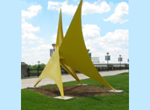Several Pieces of Public Art on the Same Theme Can Make Your Town Memorable
Here is an idea that both reinforces the branding of your community and makes the most of your public improvement dollars. On this page you will learn how to establish a public art theme by installing related pieces within a neighborhood or campus.
To illustrate this, we will talk about a successful implementation of this concept through a collection of public art sculpture in the
little artsy-craftsy town of Berea, Kentucky, USA. This very small
college town has a unique history of teaching and practicing craft skills at the local college.
At the surface level, if you travel to Berea, you will notice a good many sculptures of hands at strategic locations around the business district and college periphery. While hands are a universal feature of humanity, easily understood by even children and people who do not speak a word of the local language, possibly the most important aspect of the town's choice of this motif for public art is that the hands emphasize Berea's history and current culture of "hand-made" craftsmanship.
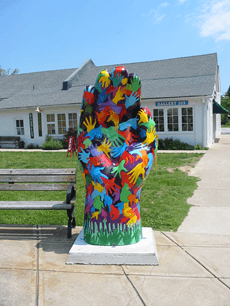
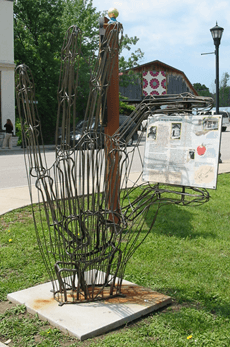
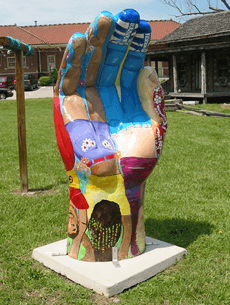
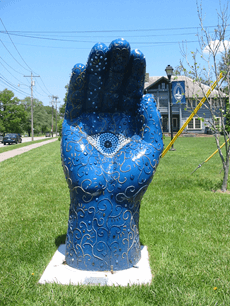
To develop a theme for your city's public art, choose pieces that are related in material, color, or feel, or all of the above. While arguably three of the four sculptures above are from similar materials, the wire sculpture enhances the theme by preventing monotony and introducing what might seem to be a more novel material.
Because the town is so small, these sculptures are even more striking. It would be less interesting for this town to have one big sculpture celebrating craftsmanship, even if it were substantial in size, prominent in its placement, and outstanding in its celebrity artist parentage. However, a number of these smaller sculptures in a variety of media and sizes creates a very effective and pleasing public art theme.
No doubt you are already thinking of the other major advantage, which is the ability to roll out the public art incrementally. Not only does this make the entire project more affordable, but also it allows your city or neighborhood to correct mistakes or alter your image as you go along. If something goes wrong with one smaller sculpture due to vandalism or unexpected weathering, filling in the gap becomes doable. If you rely on one huge statement piece, an unfortunate accident creates a real problem for the effect you are attempting to mold.
Even though there is a serious and even intellectual purpose when you establish a public art theme, but also the anticipation of residents or frequent visitors builds. It can even become a bit of a game to find the next source of surprise and delight, which are two important features of all but the most artistically significant public art installations.
Children enjoy these sculptures a great deal. An additional function is that some of them add a pop of color to an otherwise white, green, and gray space. They also fill empty space in what might otherwise be perceived as a somewhat boring lawn area on an average day in town.
In Berea these lawns probably are full of human life on the first warm day of spring or when there are large crowds at the college, but on an ordinary day, the art livens up the space.
The lesson to be learned by an artist selection committee is that the ability to carry out a theme in a recognizable but slightly unpredictable way is a very important qualification for a public sculptor.
You May Be Interested in These Related Pages
- A Good Community ›
- Community Beautification › Creating a Theme for Public Art
Join GOOD COMMUNITY PLUS, which provides you monthly with short features or tips about timely topics for neighborhoods, towns and cities, community organizations, and rural or small town environments. Unsubscribe any time. Give it a try.
